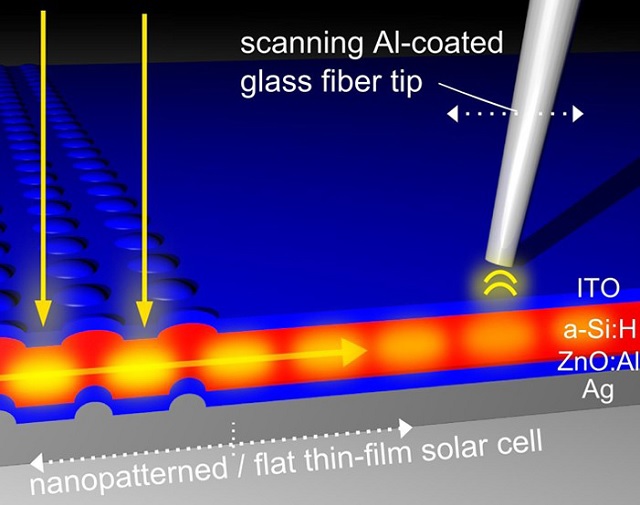 Schematic: Measuring captured light using near-field optical microscopy. Source: Forschungszentrum Jülich
Schematic: Measuring captured light using near-field optical microscopy. Source: Forschungszentrum Jülich
Scientists at Forschungszentrum Jülich have used a new method to successfully study light propagation inside a solar cell directly.
Researchers have faced difficulties when studying light which has been captured by solar cells. Previously indirect methods were used in order to analyse the light trapping that occurs within periodically nanostructured solar cells, as light that is captured within a solar cell is not visible from the exterior of the solar cell.
If a light-conducting component is brought very near to the surface of the solar cell, it can track the light inside the cell due to a quantum mechanical tunnelling effect. Jülich researchers employed the near-field optical microscopy method and used a glass fibre tip in order to measure the quantity of captured light.
When compared to conventional crystalline solar cells, thin-film solar cells can be manufactured easily using less material but they are not as efficient as crystalline solar cells. Thin-film solar cells could be improved using light trapping.
Within a thin-film solar cell, the conversion of energy occurs in a layer that has a thickness of approximately one thousandth of a millimetre. As a result, when the solar cell is exposed to sunlight directly, infrared light can be absorbed effectively.
Light incident on the solar cell can be very effectively absorbed if periodically nanopatterned interface layers are used. The incident light is coupled into the silicon layer by these interfaces.
Scientists from Forschungszentrum Jülich’s Institute of Energy and Climate Research have used a new approach to demonstrate the existence of a direct link between the nanostructure’s nature, the solar cell efficiency and the particular wavelengths of light that are absorbed. The new approach offers new ways of analysing applied nano-optical components.
This study has been published in the journal Nano Letters.